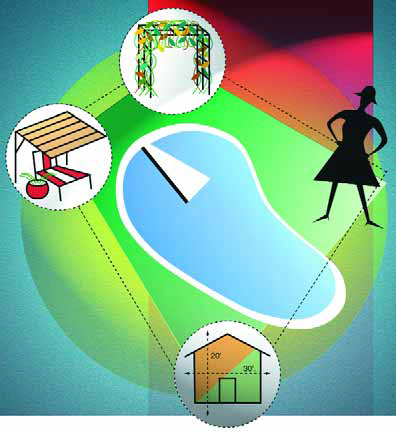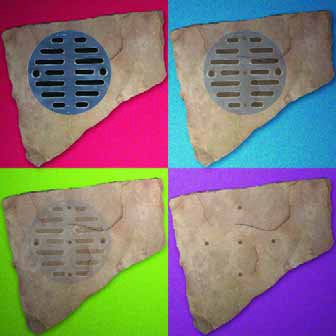Landscape, Plants, Hardscape & Decks
Contrary to the impression that might be given by the headline, this isn't an article about building arbors that are safe. Rather, it's about how you can protect your clients and their guests from the sun by building beautiful structures in their yards. (Safety is part of the discussion, too, but not its focus.) I bring this up because many clients put piles of money into building spectacular pools but fail to give much thought to their surroundings. That's a shame, because those surroundings almost certainly will be seen much more than the pools will be used in the course of the average year. Several things need to be
There's never been much of a tradition in this country when it comes to beautiful stonework, especially when it comes to flat stone surfaces. What you usually see is the same few stone types used over and over again in the same sorts of applications. To see a contrasting heritage, just travel in Europe and some parts of Asia, where you'll see a far greater variety of flat stone used in creative ways to create pathways, walls, decks, patios and a host of architectural features, including pilasters and finials. Of course, the Old World had a long head start on us, but even so, we've been slow in the New World to catch up with the masonry and quarrying trades as they've been practiced abroad for centuries. Fortunately, that's starting to change. My firm, Malibu Stone & Masonry of Malibu, Calif., supplies stone (flat and otherwise) to a host of contractors, landscape architects and designers. What we're seeing is a two-stage process: Professionals are surprised
When I meet with clients for the first time, we talk a lot about what style, design, color and other elements appeal to them. We also talk about whether they want a low-maintenance garden, or whether they want to put a lot of work into their own high-maintenance yard. Consistently, however, I find that people do not even remotely understand what I mean by "maintenance." I hear things like, "I don't need a sprinkler clock," or, more truthfully, "I don't want to spend the money on a sprinkler clock" - and I immediately
You'd think that having lousy-looking deck drains was inescapable, given that about 99.9% of them look like a thing you'd find in your shower. Whether you're using PVC or brass grates, they disrupt the surface of any decking material and to my way of thinking are an unnecessary eyesore - nearly criminal when they interrupt the look and texture of a beautiful expanse of stone. It just doesn't make any sense to draw that much attention to the drains. That's why I decided to develop a deck-drain detail that doesn't break up the visual lines of the deck. It's extremely simple - and it's something you can
I feel like I'm working backward: First, I told you about a gargantuan water lily and its very specific requirements, then I offered a more general look at water lilies that will thrive in almost any pond. Now I'm going to give you some ideas and tips for designing with all types of water plants. It might have been more logical to approach things the other way around, but the important thing is that we're ready to complete the package and talk about ways of incorporating lilies and water plants of other sorts into beautiful, overall planting designs. As always, I will avoid getting too specific with recommendations. Instead, I'll stick to basic
So you read my last article and were so excited about Amazonian Water Lilies that you'd decided to talk some clients into going for it. But alas, after measuring their yard, you recognize that you won't have enough room to accommodate the gargantuan watershape you'll need to host such an immense plant. But your clients are still hot to trot with something unusual, even after you've accepted the fact that
Some may disagree with me, but I don't see faux rockwork as a "sculptor's art form." For more than 25 years, I've made sure that Mother Nature is the one who does the detail work; what I do is take copies of her artwork to job sites and install them in creative and interesting ways. A long time ago, I developed a method of making castings of real rocks using my own formulation of fiberglass and epoxy. These are exact replicas of the real thing: Once mounted on steel structures in swimming pools or other hardscape applications, the panels are
This past summer, I had the pleasure of traveling to Europe - specifically Northern Italy and Southern France. Along the way, I was lucky enough to see the lavender fields of Provence in peak bloom and many unusual and beautiful gardens. My travels were particularly rewarding in the region around Lake Maggiore in Northern Italy, well known for having some of Europe's most beautiful gardens. We started off by visiting the islands on the lake and their villas, complete with their classic-style gardens. The climate of the area allows for growing many of the plants I'm familiar with in Southern California, but the
Just as every garden should reflect the aesthetic values of its owners and accommodate their lifestyle preferences, so too every watershape should reflect the nature, purpose and "meaning" of the garden it inhabits. If it's a Victorian garden, then the watershape should be of similar style - perhaps a blend of formal and natural elements with stone or brick accents. If the theme is "wild, romantic tangle," then cascades, blossom-laden pools and rambling roses may be in order. For its part, a simple, paved court may call for a






















